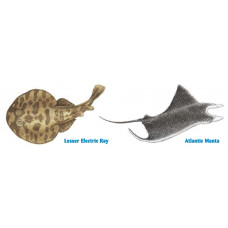Latin name
No information
Other names
Lesser Electric Ray, Atlantic Manta, Smalltooth Sawfish, Southern Stingray, Atlantic Stingray, Skate Egg Case, Common Skate.
Identification
Among the dominant distinguishing features of this order are the gill openings, located entirely on the ventral surface, and the anterior margins of the pectoral fins, connected to the sides of the head and positioned forward past the five pairs of gill openings. Eyeballs not free from upper margins of orbits as in sharks, and anal fin absent. Most members of the order Rajiformes are easily recognized by their shape. Their body is flattened dorsoventrally, and the pectoral fins are widely spaced and appear to be part of the body. The caudal parts are more or less separated from the body, the eyes, and spiracles are on the upper side, and the mouth and gill openings are on the lower side.
Distribution
This species is found in warm Atlantic waters from North Carolina to Brazil. One of the most common stingrays on the Atlantic coast of North America is the blunt-nosed stingray (Dasyatis say) It is found from New Jersey to Argentina and is widely distributed in the West Indies. The Atlantic (D. sabina) yellowish-brown stingray is found from the Chesapeake Bay to southern Florida and the Gulf of Mexico. More common than the Atlantic stingray and found from New Jersey to Argentina is the southern stingray (D. americana). The Lesser skate (R. erinacea) is the most common species of skate on the Atlantic coast of North America, from Nova Scotia to North Carolina. The great skate (R. binoculata) is found from the Bering Sea and Aleutian Islands to Baja California, Mexico. The California horse (R. inornata) is found from British Columbia to central Baja California. The barndoor skate (R. laevis) is common from Newfoundland to Cape Hatteras.
Habitat
Most Rajiformes live on or near the bottom and are relatively clumsy. Some of them lie buried in the sand or silt most of the time, and are poor swimmers. Skates are capable of moving quickly when needed, although they usually swim slowly and close to the bottom. Sawfish also spend most of their time near the bottom, but rise to chase fish. Eagle stingrays are quite active and often swim close to the surface, although they do feed on the bottom. The manta spends most of its life swimming near the surface or not too far below it.
Size
Members of this clan range in size from just a few inches to giant mantas with a span of about 23 feet. Impressively armed sawfish reach more than 20 feet in length. The fine-toothed sawfish (Pristis pectinata) is usually 15 feet long and sometimes reaches 20 feet. It can weigh up to 800 pounds. The blunt-nosed stingray (Dasyatis say) is about 3 feet across. The Atlantic stingray (D. sabina) is just over a foot across and has very round wings. The southern stingray (D. americana) averages about 3 feet across. The little horse (R. erinacea) is about 11⁄2 feet long and weighs only about a pound. The great horse (R. binoculata) reaches a length of 8 feet. The more numerous California horse (R. inornata) reaches an average length of 2 feet. The barchan stingray (R. laevis) is one of the most aggressive stingrays, reaching a length of 5 feet.
Life history and Behavior
No information
Food and feeding habits
Stingrays and skates feed on a variety of animal foods, including all available invertebrates that live on the sandy or muddy bottom. Eagle rays, as a group, prefer hard-shelled clams, while sawfish sometimes leave their bottom food to crash into a school of closely huddled fish. Electric rays are strictly fish-eating animals, sometimes capturing surprisingly large prey compared to their size. The manta feeds on tiny plankton, small crustaceans and small fish.
Reproduction
No information
Interesting facts
Stingrays have a very peculiar way of breathing. They have a hole in the top of their head with a valve. When they 'breathe in', the valve opens and water flows freely through the hole to the gills; when they breathe out, the valve slams shut and the water comes out through the gill slits.
| Classification | |
| Phylum | Chordata |
| Class | Chondrichthyes |
| Squad | Rajiformes |
| Family | Rajidae |
| Features | |
| Conservation status | Least Concern |
| Habitat | Pelagic |
| Life span, years | No information |
| Maximum body weight, kg | No information |
| Maximum length, cm | 180 |
| Sailing speed, m/s | No information |
| Threat to people | Edible |
| Way of eating | Bentophage |
Rays and Skates
Tags: Rays and Skates










